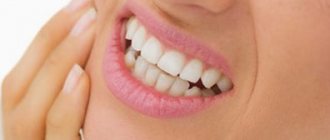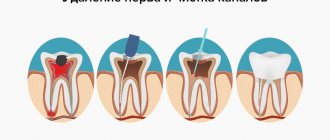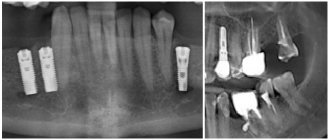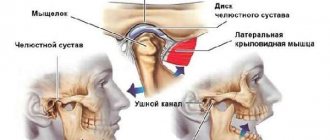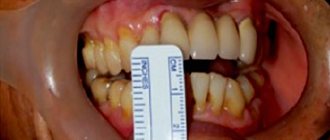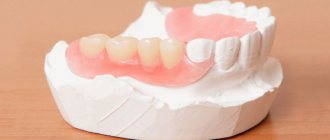Self-diagnosis of the problem
Not every person can accurately determine the source of pain in the teeth. And yet you need to try to do it. To begin with, you should thoroughly clean the chewing organs. Then you need to go to a mirror with a good light source and take a close look at your teeth. The patient often changes color and this differs from healthy masticatory organs. It may be yellowish or brown. Darkening of color occurs due to pathological changes in the dental pulp. If it dies, it becomes toxic, like any decaying organism. And toxins come out through the pores in the tooth and change its color.
In addition to darkening (at the initial stage of the disease it may not yet be present), there may be gumboil or inflammation of the gums near the diseased tooth. Such signs can be seen visually. If you press on the lump, it will cause pain.
The gums around the diseased tooth may also bleed. The pain sometimes radiates to the throat, the temperature rises, the cheek swells, and a headache begins. In addition, a person feels an unpleasant taste in the mouth, and those around him hear a rather pungent sour smell.
Even if there are no these symptoms, then you should rush to see a doctor, who will definitely determine the source of the pain.
How to determine which tooth hurts?
Alexei Kireyev Master (1941), closed 8 years ago
The entire right upper part of the jaw hurts, starting at 3 am. The dentist looked carefully, including an x-ray, applied cold and heat to each tooth separately, and knocked on them. I don't feel any difference. He said that most likely the nerve is in one of the teeth, but we need to wait until it completely hurts to understand which one. What do you advise?
There are hidden carious cavities that are not visible during examination and are not always visible on an x-ray. I encountered this problem the hard way, when together with a candidate of medical sciences in a good center we looked at a panoramic image and both did not see the problem. until the palatal cusp of the diseased tooth fell off. Anything can happen, in dentistry all sorts of miracles happen. There is such a simple technique - electroodontodiagnosis. Teeth are checked for electrical excitability. 100 percent authenticity. A healthy tooth has a certain indicator of electrical excitability in microamperes. a tooth with average caries is another value. Deep caries is another indicator. Pulit - specifically the numbers after 20 microamps. and then different states of the pulp. where the numbers point to pulpitis, open it there. I also know from work experience that first of all you need to look at teeth with large fillings and old fillings. And also think about whether there is neuralgia, because paroxysmal pain can be associated with this.
Source: I am a dentist
La femme Guru (3996) 8 years ago
It sounds trivial - go to the doctor, sometimes you need an x-ray, I didn’t finish reading. look for the penis - it's a nerve
Daughter of the Dew Sage (16968) 8 years ago
Did the X-ray really show nothing? Yes, this is problematic because the innervation of the teeth is continuous. Well, by appearance, is it not clear which of the teeth is bad? If the teeth are not destroyed anywhere, then the gums may be inflamed. It can swell, fester, and there will be a gumboil (abscess). Then they will open it. The temperature may rise. I don’t know, you can usually determine that this particular tooth hurts if you press on it with your finger and it hurts, or if you bite down.
Lisik Thinker (9463) 8 years ago
They tested me with electric shock to see which of my teeth hurt. And then they checked it with X-ray. It helped!
Svetlana Shumova Expert (269) 11 months ago
I think I need to change dentist! It’s impossible that the doctor won’t recognize the source and cause of the pain, even after an X-ray, so it’s better not to wait and suffer, but to see a good doctor! I usually make an appointment through the portal https://docdoc.ru/doctor/stomatolog/?pid=5191 very convenient and fast and the specialists are very good, which is very important in this situation. and no queues! read the reviews and you will know who you are going to and what you are getting!
Roostic AlyusheFF Student (175) 9 months ago
Could it be a wisdom tooth that broke off 2 months ago?
How does a doctor identify a bad tooth?
It is much easier for a specialist to diagnose. First, the dentist uses a fairly simple method - tapping the teeth with a metal instrument. The patient's response helps pinpoint the source of the pain.
But this diagnostic method is not ideal. Therefore, dentists send a person for an x-ray. It is worth noting that many privately practicing dentists today have modern visiographs in their offices. They allow you to take a picture right on the spot and quickly and accurately identify the diseased masticatory organ.
If the patient’s tooth is pulpless, then it may contain a granuloma or cyst. The specialist will see this as a dark spot. Such a tooth can be treated.
In addition to caries and pulpitis, there may be other causes of toothache. This is a suppuration of a cyst, an abscess. And if you endure the pain and drown it out with painkillers, then you can lead yourself to osteomyelitis - the transition of the inflammatory process to bone tissue. Therefore, you should not hope that the pain will go away on its own and delay treatment. You can rinse your tooth with salt and soda or a solution of calendula tincture, and then rush to the dentist.
What to do if your tooth hurts?
If there is no dental clinic nearby or it is closed, then you need to look for a way out on how to numb the painful tooth. Moreover, if the whole jaw ache, and you can’t tolerate the discomfort (what to do if your teeth ache?). There are a number of medications that can save a person from painful toothache. However, it should be noted that all medications have their own side effects.
Medicines
- The most popular are preparations based on nimesulide. The group of non-steroidal anti-inflammatory drugs has not only good analgesic, but also anti-inflammatory effects. These include Nise, Ketanov, Ketorol. Good old Analgin will also help.
- You can also use solutions of valerian and peppermint for rinsing. They disinfect and have a calming effect.
- It would not be superfluous to use local anesthetics, for example, a solution of Lidocaine in the form of a spray.
These medications will help treat the pain, but not the cause. No one canceled a trip to the doctor.
Folk remedies
Traditional methods include baths and rinses:
- chamomile, sage, St. John's wort - have an anti-inflammatory effect, have a beneficial effect on the condition of the gums, disinfect the oral cavity, thereby reducing pain;
- salt and soda (1 teaspoon of soda and salt per glass of water) - draw pus from formed granulomas;
- a weak manganese solution will relieve swelling and cleanse the cavity of microorganisms;
- lotions with Kalanchoe juice, aloe, propolis.
Pulpitis as a cause of acute pain
If caries is not treated promptly, it will lead to the development of pulpitis. Unfortunately, this happens to many people. When a thin layer separates the pulp chamber and the carious cavity, then toxins secreted by microbes reach the vessels and nerve. This contributes to the development of the inflammatory process. Soon there is a direct communication between the camera and the cavity. Pulpitis intensifies.
By the way, sometimes this dental disease can be the result of the toxic effects of filling material. This happens when the insulating gasket is applied poorly or is missing altogether.
Pulpitis can also be a consequence of tooth trauma. This often occurs among athletes.
The main distinguishing feature of the disease is sharp shooting pains. They occur or intensify at night. Less commonly, increased pain can be caused by temperature changes or consumption of hot food. It is with pulpitis that difficulties most often arise in determining the source of pain. After all, half of the jaw, throat, face can hurt.
If we are talking about chronic pulpitis, then it manifests itself as aching pain. Sometimes this type of disease can be asymptomatic.
Healthy teeth are an indicator of a healthy body. But sometimes it appears unexpectedly and it is difficult to determine its exact location. This is especially difficult to do if the pain is intense. The pain can radiate to the ear, back of the head, neck, and intensifies when yawning and chewing food. However, it is possible to determine which tooth hurts.
How to understand where it hurts
You can understand which tooth hurts with the help of an external examination. It does not give a 100% result; after self-examination, you should consult a dentist. You can find out where toothache can go in.
Inspection using a mirror
You need to take a mirror and carefully examine the oral cavity. A damaged tooth will differ from healthy ones in color and presence. As it breaks down, it turns brown or yellow. Internal tissue damage occurs.
Additionally, an inflammatory process in the gums may be observed near the diseased tooth, as well. If you press on it, it will cause severe pain. After a while, pus appears.
Light tapping
The easiest way to find out which teeth hurt is to knock on them with a spoon, but gently.
The tooth that is most damaged will respond quickly. But such an examination does not always give a positive result.
We find out the circumstances of the problems
It is important to pay attention when toothache symptoms appear. If painful sensations occur after eating cold or hot food, blowing cold air, sweet or cold food, then it is possible that the gums are hurting, not the tooth.
Because of this problem, it may. Again, you need to carefully examine all the gums using a mirror.
How to relieve pain
With caries, an inflammatory process appears near the gums. Redness appears, and later - flux. The pain is initially felt only with pressure, but gradually begins to progress.
We suggest you read: Why does a person’s tongue have cracks?
If the tooth hurts severely, but the intensity increases with tapping, then this may be due to a cyst. The pain can be tolerated or suppressed with medications, but the disease develops gradually. Inflammation in the bone may develop.
With the inflammatory process in the trigeminal nerve, the pain is aching and constant. It may periodically intensify. Sometimes painful shooting sensations are felt.
What to do if your tooth hurts badly? Take painkillers. If you don’t know which ones, we will help you.
- Ibuprofen and Nurofen. Relieves or dulls pain. Valid for up to five hours. If an urgent need arises, nursing mothers can also use it in the correct dosage.
- "Analgin." Of course, it relieves pain, but it is better to choose another remedy. As a last resort, if there is nothing else, then you can drink it. Analgin affects the functioning of the heart.
- My wisdom tooth is sick, what should I do? You can take Paracetamol. It is able to dull pain and stop the inflammatory process. It is strictly forbidden to mix with alcohol.
- As for aspirin, it can be taken not only orally, but also applied to the sore spot. It is important to know that such onlays can only be done if the tooth cannot be saved.
- "Ketanov" and "Ketarol" help with severe pain. When your feet are cold and your tooth hurts, what should you do? When you drink one of these medications, it starts working within fifty minutes. Their use by pregnant women and during lactation is prohibited.
- "Corvalol" and "Validol". Helps with pulsation. The tablets can be applied directly to the gums, and lotions made from drops on a cotton pad reduce pain. It cannot be used on an ongoing basis, only in cases of emergency.
What may lie behind dental symptoms?
Don't forget about wisdom teeth
Another reason for the appearance of pain in an unknown place is. They may not grow properly.
Wisdom teeth are located near the facial nerve, ear and throat, so discomfort is often felt in these places.
Inflammation of the trigeminal nerve
Another reason why the whole jaw hurts may be. The trigeminal nerve runs throughout the face, as its three main branches are located on the cheek. One from the ear goes towards the lower jaw, the second - to the eyes, the third - to the upper jaw. In most cases, pain occurs due to hypothermia.
Perhaps it is due to other diseases
Toothache can accompany other problems, for example:
- sore throat;
- headache;
- otitis
These diseases and conditions can aggravate existing dental problems, and sometimes they simply create painful sensations in the oral cavity.
Why does one tooth hurt, but the whole jaw ache?
It often happens that the entire jaw hurts, but it is not possible to find out which tooth is bothering you. The cause of the problem lies in the anatomy of the human body. The trigeminal nerve, which runs in the facial region, is a large bundle from which three branches arise. One of them is directed to the fronto-orbital region, the second to the upper jaw, and the third to the chin and lower jaw. Based on this, you can understand why the pain radiates.
Sometimes toothache is confused with trigeminal neuralgia, but these conditions should be distinguished. During toothache, the trigeminal nerve contributes to its spread throughout its entire length, but itself remains healthy.
Examination by a doctor
If it is not clear which tooth is causing the pain, it is best to consult a dentist. It is much easier for a doctor to diagnose. He uses his professional knowledge during the inspection. The dentist performs a palpation procedure. Additionally, in this way it is possible to determine whether tooth mobility has appeared.
A professional can identify a diseased tooth by tapping metal or applying heat to the gum.
Visual examination and palpation sometimes does not help to establish an accurate diagnosis. Many dentists use a safer method -. This is innovative, high-precision equipment that allows you to reduce the procedure time when obtaining images due to the absence of an intermediate step in developing the film, and reduce the level of radiation exposure.
The source of pain can be determined using a CT scan, a targeted or panoramic image. The doctor recommends the option that is best suited in this situation.
With the help, you can see what condition the canals are in, whether there are cysts near the tooth root, or defects in the cervical area. Additionally, the image can show a wisdom tooth if it is just starting to grow and causes pain.
The best option is a panoramic shot. Some dental offices do it right on the spot.
If the dentist sees no reason
It happens that a tooth hurts, but the doctor says that everything is fine. Sometimes the entire jaw can ache due to stress. The pain is aching, and it is impossible to determine which tooth is manifesting itself. This often occurs among people who cannot express their opinion or, in the event of a conflict, very often try to remain silent. We are talking about psychosomatics.
The cause may be the presence of intervertebral hernias or protrusions in the cervical spine. If a nerve is pinched and irritated, the pain can be very intense.
In this case, the doctor will not be able to determine the cause either during the examination or after the x-ray. You need to contact a neurologist.
Sometimes pain can be a consequence. Even when the jaw is completely healed, it can still react to changes in the weather. Such pain goes away on its own after a few days.
If teeth have nothing to do with it
Sometimes it is not clear which tooth hurts. It may even seem like everything hurts at once. But dental disease is not always the cause. Similar symptoms may indicate other problems:
- inflammation of the trigeminal nerve,
- cancerous tumors in the oral cavity,
- ENT diseases: sinusitis, sinusitis, otitis media,
- hypothermia,
- salivary stone disease,
- dysfunction of the temporal mandibular joint,
- pathologies of the cardiovascular system: for example, angina pectoris,
- intervertebral hernia, pinched cervical nerve,
- psychosomatic state of a person: it may simply seem to you that your teeth are aching, especially if you have recently suffered stress,
- Jaw Fracture: Discomfort may occur even years after you have been treated. Some people note that in this way the body and the bones that have grown together after injury react to changing weather.
It is important to understand that internal diseases of the body can aggravate dental problems or contribute to their occurrence, just as, conversely, diseased teeth can cause other pathologies, such as sinusitis. This occurs due to the fact that infections from the source of inflammation can freely penetrate into all adjacent areas.
We suggest you read: What is stronger: ketorol or nimesulide?
Characteristics of painful sensations in various diseases
When appears. Its redness appears, later -. The pain is initially felt only with pressure, but gradually begins to progress.
If the tooth hurts severely, but the intensity increases with tapping, then this may be due to. The pain can be tolerated or suppressed with medications, but the disease develops gradually. Inflammation in the bone may develop.
With the inflammatory process in the trigeminal nerve, the pain is aching and constant. It may periodically intensify. Sometimes painful shooting sensations are felt.
It often happens that with severe toothache, people try to independently determine which tooth hurts. And sometimes it happens that this can be done.
But when you go to the dentist, it turns out that it’s not the wrong tooth that hurts. So how can you correctly determine which tooth is causing so much discomfort before dental care is provided?
It is important to note the fact that in most cases it is impossible to independently determine the source of pain. Since the dentist himself often cannot determine such things as the source and cause of severe pain without modern technology, you should not count on making the correct diagnosis on your own.
First, you need to thoroughly brush your teeth so that no traces of food remain.
After this, you need to examine your teeth in good light in the mirror. A tooth that hurts is often a slightly different color from healthy teeth. Due to the processes that occur in the dental pulp, the diseased tooth begins to darken slightly.
In addition to the fact that the tooth may become darker, inflammation - gumboil - may appear near the diseased tooth. In addition, you may notice that the gums near the sore tooth may become swollen and red. The gums may also begin to bleed. In this case, the pain may be felt in the throat, and not on the gum. When you have a toothache, you almost always get a headache, an unpleasant bitter taste appears in your mouth, and the smell from your mouth becomes sharp and sour, which also causes a lot of awkwardness and discomfort.
The dentist first tries to identify the diseased tooth by tapping the teeth with special metal instruments in the area of pain. But since this method cannot always help in accurately identifying the diseased tooth, doctors send the patient for a dental x-ray. If it suddenly turns out that the patient has a dental granuloma or a cyst, the dentist can always treat such a tooth.
It is not recommended to endure toothache and suppress it with pills for a long time without seeing a doctor, because the pain can be caused by inflammatory processes, such as developing pulpitis or an abscess. Such “silencing” of pain can lead to serious complications, for example, osteomyelitis, which implies the transfer of inflammation to the bone.
Since untimely treatment or completely ignoring the symptoms of caries can lead to pulpitis, it can become one of the causes of severe toothache. When there is a very thin layer between the pulp chamber and the carious cavity, toxins can reach the vessels and nerve endings. This helps inflammation develop, since over time this thin layer practically disappears and the infection begins to freely penetrate the vessels. This contributes to the development of pulpitis. Sometimes the filling material can cause infection. This can happen if the patient’s tooth was poorly treated.
In addition, the development of pulpitis can cause serious mechanical trauma to the tooth.
If a person has sharp shooting pains that become stronger during sleep or at night, then this is a clear sign of pulpitis. Sometimes the pain may worsen when eating hot or cold foods. If such pain occurs, you should immediately contact your dentist. It is with a disease such as pulpitis that it is most difficult to determine which tooth hurts, because the throat, part of the jaw, and even occasionally the lower part of the face begin to hurt.
Dentists only speak positively about the fact that taking painkillers for a short time before going to see a doctor is a temporary means of “dulling” the pain.
We must not forget that it is important not to heat the tooth, gum, or jaw in the area of pain, as this will not only aggravate the pain, but can also cause certain difficulties in further specialized treatment. At the same time, if you apply the medicine to a painful area, then you don’t need to “push” it directly into the tooth, this will only bring unnecessary severe pain.
It is worth remembering that there are many other dental diseases, especially chronic ones, which can be asymptomatic. Therefore, it is necessary to contact the dental department immediately after the onset of toothache.
The ability to feel pain is vital for every person - it is a signal to action, indicating that something has gone wrong in the body. As a rule, the spontaneous appearance of pain is a kind of indicator of unwanted changes in the body, and its intensity determines the severity of these changes. And toothache here is no exception to the rule - it should be perceived precisely as a signal for immediate action, so it is useful for every person to know what to do when a tooth hurts badly.
Generally speaking, a tooth can begin to hurt for various reasons: due to caries, pulpitis, periodontitis, periostitis, etc. Often even inflammation of the gums provokes toothache. The most striking example is the difficult eruption of wisdom teeth, when the gums become inflamed and swollen so much that the pain radiates to neighboring teeth, and sometimes even to the ear or throat.
Dental diseases of carious and non-carious origin also determine the different nature of pain. For example, the most severe pain most often occurs due to structural changes in the soft tissues inside the tooth - the pulp.
The pulp is a neurovascular bundle that consists of a huge number of nerve cells. With inflammation and destruction of this tissue, such acute and severe pain can occur that a person literally cannot find a place for himself.
Unfortunately, not everyone makes the right decision about what they should do when a toothache appears: some wait until the last minute and endure, others swallow pills in the hope that everything will “resolve” by itself. There are many cases when people wait an unreasonably long time for their wisdom teeth to erupt, although such waiting against the background of severe inflammation can be very dangerous from the point of view of the development of severe complications.
What to do if your head starts to hurt badly from toothache?
Indeed, toothache can sometimes radiate to the head, thereby provoking a severe migraine. Typically, such pain is of a short-term “shooting” nature. However, with “crooked” growing wisdom teeth, which, due to their incorrect position in the gums, damage the roots of neighboring teeth during their growth, the headache can be constant, becoming chronic. In such cases, the offending wisdom tooth should be removed as soon as possible, after which the headache will quickly go away.
Sometimes a headache is associated with the presence of deep caries in a tooth. As soon as the tooth is properly treated, the headache will go away.
Pain after installing braces
If in the cases described above we easily found a way to determine which tooth hurts and what to do to reduce the pain, then after installing braces it is quite difficult to get rid of the pain. The fact is that the procedure for fixing the locks itself is painless, but after this very unpleasant sensations arise. As a rule, the patient makes the following complaints:
- I don’t understand which tooth hurts;
- nothing helps relieve pain;
- the pain lasts 3-4 weeks;
- The tooth hurts a lot when eating.
The fact is that after the braces were put on. teeth shift. The vacant space is filled with bone tissue. Here it is difficult to determine which tooth is bothering you, since it seems that the entire jaw is aching. To some extent this is true, because we artificially force our teeth into the desired position.
Some patients experience severe tooth pain after fixing locks, while others do not notice any discomfort. The intensity of pain depends on individual characteristics. In addition, the method of installing braces matters. So, with vestibular fixation, pain persists for 2-5 days, but with lingual fixation, pain persists for several weeks. The pain spreads across the jaw or radiates to the tooth, which is subject to the load of the orthodontic structure.
Having understood the reasons, let's try to figure out how to relieve the pain from braces. First of all, come to terms with the idea that pain at the beginning of orthodontic treatment is normal. You can take a painkiller. It is better to consult your dentist so that he can prescribe you a medicine to relieve pain.
We suggest you familiarize yourself with Discomfort in the lower jaw
After this, you need to adjust your diet. How do you know which product is not right for you? All hard foods and chewing gum are contraindicated during orthodontic treatment, as they increase the load on the teeth and increase pain. It is also recommended to use a special toothbrush, which will not allow increased load and will allow you to thoroughly clean the gaps.
https://www.youtube.com/watch?v=zE9joI1LPGg
Gels, such as Dentol, are used to reduce pain. Rinsing with herbal decoctions such as mint or lemon balm will also help. During orthodontic treatment, gum inflammation occurs, so you should know this complication and what to do in this situation. The inflammatory process manifests itself as redness and bleeding.
Possible causes of toothache
Suppose you have a toothache and you don’t know what to do: either wait a couple of days, hoping that the pain will go away on its own, or is it better to immediately make an appointment with the dentist... So let’s talk about the possible root causes of toothache and the mechanisms of its occurrence, understanding of which will help make the right decision in different situations.
So, let's start with pain, which is a characteristic sign of caries. Already in the initial forms of caries, a feeling of soreness and increased sensitivity of foci of enamel demineralization (that is, areas of enamel with partially washed out mineral components) may appear. At this stage, in order to prevent further destruction of hard tissues, it would be necessary to undergo a course of remineralizing therapy as quickly as possible (at a minimum, use remineralizing toothpastes).
However, severe pain can appear only when carious destruction reaches the enamel-dentin border - in this case, tooth tissue becomes sensitive to various irritants (cold, sweet, etc.). In such situations, to quickly get rid of unpleasant sensations, it is enough to simply eliminate the irritant, and the pain will immediately go away. However, of course, for full treatment, it will no longer be possible to do without a filling.
Pain with medium and deep caries occurs due to the fact that the dentin layer is penetrated by many dentinal tubes that nourish the tooth and determine its sensitivity (and also have a certain connection with the dental “nerve”). When the dentin layer is destroyed, something like a dentin “wound” appears, which reacts to the action of irritants.
Question to the dentist: “Why does the tooth hurt under an old filling, and what should be done in such a situation?”
If the filling was placed more than 5-7 years ago, then significant shrinkage (punching) of the filling is possible. At the same time, its adherence to the edges of the tooth is disrupted, therefore, with a “living” pulp, it sometimes painfully feels the irritant (cold, hot).
A tooth that has been filled in canals for a long time with a high-quality sealed filling usually does not bother you if no errors occurred during treatment. If the old filling no longer meets the requirements for tightness, or even falls out in pieces, then the dead tooth begins to hurt due to infection in the already sealed canals. In addition, during the treatment, mistakes could be made: an incompletely sealed canal with an infection left in it, a breakage of a dental instrument in the canal, etc. All this, over time, can also cause inflammation at the root of the tooth and pain.
In any case, if you experience pain in a tooth under an old filling, you should immediately contact your dentist, as this is a sure sign of the development of pathological processes.
Now let's see what to do with tooth pain due to pulpitis.
In acute pulpitis, the neurovascular bundle inside the tooth undergoes catastrophic changes.
Inflammation that occurs due to the action of microbes and their toxins on the living tissue of the “nerve” causes its swelling and gradual necrosis.
It is not difficult to imagine: the pulp gradually begins to “swell”, increasing in size, and when the pulp chamber is not opened, it is strongly pressed against the inner walls. The nerve endings are compressed, and acute pain occurs, which can only be relieved by strong painkillers.
Thus, with pulpitis, in most cases, canal treatment will be required, that is, a simple filling will no longer be enough.
This is interesting: why sometimes there is a sharp pain after arsenic is installed in a tooth, and what can be done to prevent this from happening?
Doctors of the old school still continue to use arsenic paste, and legends and myths about a terrible dental monster called Arsenic appear among the people. If you correctly perform all the stages of applying the paste and maintain the required time for its presence in the tooth, then there will be no direct toxic (negative) effect leading to severe toothache.
However, in practice, it is difficult to control the process of the presence of the substance in the tooth by the hour, especially since the dosage of the paste is also very conditional (ball-shaped bur head No. 1). Many dentists still wonder, even if they have seen or know what size this head is, how realistic it is to determine its volume for each specific patient and his tooth.
A study by scientists on the effects of arsenic acid on the tissue around the root revealed the risks of developing serious inflammatory processes, even cysts, which often leads to tooth extraction. It is for these numerous reasons that it is easier to refuse arsenic even in budget dentistry.
In addition, sometimes by mistake the paste is installed on an unopened pulp chamber. As a result, the arsenic-containing compound cannot quickly kill the dental “nerve” through the remaining dentin layer, but thanks to the dentinal tubules, it actively irritates it, which causes severe toothache. What to do in such a situation? – get an appointment with your doctor as quickly as possible, without waiting for the appointment date.
Dental examination
When examining the oral cavity, the dentist uses several methods to determine the location of pain and its cause. Doctor:
- taps teeth with a dental instrument;
- affects them with cold;
- sends for radiography.
The main task during the examination is to find out the localization of the pain syndrome and its intensity. Often the pain spreads throughout the jaw, which leads the patient into a state of despair.
Causes of aching teeth:
- thinned enamel;
- cracks in the enamel;
- exposure of the neck of the tooth;
- gum problems;
- enamel whitening;
- somatic diseases of internal organs;
- hormonal changes;
- frequent stress;
- hereditary factor;
- malocclusion;
- tooth extraction.
Thinning enamel
This is a common cause of pain. The protective layer is not able to protect the soft tissues of the tooth from the influence of cold/heat, chemical effects of acid. When consuming the products, a person experiences excruciating pain, which goes away over time. People refuse cold drinks, hot food, and sweets so as not to experience a painful condition.
Thinning can occur with constant enamel whitening using professional or folk remedies. Therefore, dentin and the inner layers of dental tissue suffer from changes in temperature or changes in acid-base reaction. If you do not eat pickles and sweets, do not eat ice cream and hot soup, the pain does not manifest itself.
Also, thinning of the enamel can occur due to a lack of vitamins in the diet necessary to maintain the density of the covering layer. Because of this, dental problems arise, and the teeth become hypersensitive to any influence.
Night grinding of teeth and abnormal jaw structure contribute to the rapid abrasion of the covering layer. An incorrect bite leads to thinning, as the teeth chew food in extreme mode. It is advisable to correct the bite in childhood. The listed reasons lead to generalized abrasion of the enamel layer, which causes aching of all teeth.
Cracks in enamel
This condition can occur due to mechanical impact on the teeth due to impact, trauma, or excessive pressure. Sometimes, instead of cracks, chips appear, which opens the way for various pathogenic bacteria to the dentin. All this causes discomfort when eating and drinking.
Enamel can crack due to a lack of minerals, as well as when intensively brushing your teeth with too hard toothbrushes. Cracks often appear with frequent consumption of too cold or hot drinks, as well as with a sharp contrast in temperature.
Gum diseases
Gum pathologies occupy one of the first places among dental diseases. Loose gums harbor entire colonies of pathogenic bacteria; the affected tissues cannot firmly hold the teeth. As a result of the development of periodontitis, the cervical zone of the molars is exposed, which reacts sharply to any temperature changes or a shift in the acid-base balance.
Our body is a single system in which all organs are interconnected. A problem in one organ negatively affects another or affects an entire organ system. Problems with the gastrointestinal tract affect the condition of teeth and enamel.
The nervous system also affects the condition of teeth. With constant stress, caries appears, gums hurt, and the enamel becomes covered with cracks.
An inflamed facial nerve located in close proximity to the teeth leads to discomfort in the jaw or individual molars. The nerve becomes inflamed due to stress and hypothermia.
Teeth can hurt with frequent colds, laryngitis and sinusitis. Often, damage to enamel and dentin appears when the disease is caused by osteochondrosis of the cervical spine. Infection in a flu-like state can penetrate the dental nerves.
Another reason why teeth hurt is hormonal imbalance. Almost all pregnant women experience unpleasant sensations in the jaws in the first months of pregnancy. My teeth ache, my jaw hurts, and this condition is often accompanied by a headache. Subsequently, individual molars begin to deteriorate. The same situation occurs during menopause, when the body cannot cope with hormonal changes.
With angina pectoris, pain in the jaw or teeth is also noted. Also, attacks of angina may be accompanied by drying of the mucous membranes of the oral cavity, which causes a feeling of thirst.
Pain syndrome occurs:
- local;
- generalized.
In local syndrome, a single molar responds to the impact. The cause of this condition is carious tissue damage or a reaction to orthopedic products - dentures, crowns.
With generalized syndrome, the entire jaw ache. The cause of this condition can be pathologies of the gums, severe thinning of the enamel layer, or pathological changes in the tissues of the teeth.
What to do if you have aches in your teeth or jaw? Treatment is determined by the cause of the pain:
- pathology of periodontal tissues;
- elimination of carious areas;
- strengthening the enamel layer;
- laser/ultrasound treatment.
To reconstruct the enamel layer, various mineral compositions based on potassium and fluorine are used. This procedure takes a certain period of time depending on the degree of thinning of the enamel coating.
For inflammation of the trigeminal nerve, first aid is to urgently take analgesics. If the nerve becomes inflamed late in the evening, you should see a neurologist the next day.
If your jaw hurts and your temperature rises, you need to take an antipyretic and pain reliever. Ibuprofen, Analgin, Sedalgin, Pentalgin help well. The gums can be lubricated with gels containing novocaine or lidocaine.
You should take a small mirror and carefully examine the entire oral cavity. A tooth that is damaged will differ from healthy ones in the presence of black spots and color. As teeth decay, they acquire a yellowish and brown tint. This is due to the fact that internal tissues are affected.
In addition, inflammation and sometimes gumboil may occur on the gums in the area of the damaged tooth. When pressing on the flux, severe pain will occur, and after a while purulent exudate will appear.
How else can you determine which tooth hurts?
We suggest you read: Bleeding gums: reasons, how to treat and what to do at home
Folk remedies for toothache, and in what cases they can be used
What to do if a toothache takes you by surprise - for example, during a business trip, or during long holidays? If it is not possible to get an appointment with a dentist in the near future, then you can temporarily help yourself.
Traditional methods of getting rid of toothache have been known for a long time. Unfortunately, not all of them are equally effective, but in some cases they can provide some effect.
One of the popular remedies is rinsing the mouth with a warm sage decoction. One tablespoon of sage should be poured into a glass with boiling water and left for an hour. Rinse with the solution every 10-15 minutes.
The anti-inflammatory effect of sage has been known for a long time. It can also be used in cases where the gums are swollen, gumboil has appeared, and also when a wisdom tooth erupts and the pain radiates along the branches of the nerve to the ear, temple or back of the head. When rinsing, it is important to use a warm, almost hot solution and keep it near the diseased tooth or gum to enhance the therapeutic effect.
On a note
Rinsing can also be done with tea, as long as the heating comes from the inside. You cannot heat your tooth from the outside! There have been cases when, the night before an appointment with a dentist, people warmed a sore tooth using a radiator or a hot water bottle as a heating pad. When, after such a procedure, the cheek swelled to incredible sizes overnight, only maxillofacial surgeons could help.
There is also this: you need to put a piece of propolis on a tooth or in a carious cavity, close your mouth and hold for 15-20 minutes. It is believed that pain comes already in the first minutes of action of this folk medicine, known to our ancestors. However, in practice, this technique helps only in very rare cases.
Some more quite funny folk methods for relieving toothache:
- Squat. It has been observed that vigorous physical activity improves blood circulation and helps relieve pain. In practice, squats will not help in every case.
- Apply garlic to your wrist. In the relevant literature, it is recommended to tightly fix the paste of fresh garlic with a plaster to the wrist of the hand opposite the diseased tooth. To prevent burns, place a bandage or thick cloth under the garlic. In practice, the method is ineffective.
- Warm your feet in hot water. This procedure is not only a maneuver to distract from pain. By increasing blood circulation in the body during the procedure of steaming the legs, metabolism improves and toxins are removed from the tooth pulp faster: you need to immerse your legs in hot water and keep them there for at least 15 minutes. Then you should put on warm socks and go to bed. In some cases, this method really works.
The simplest and most effective way to get rid of toothache at home is, perhaps, warm rinsing with a solution of soda and salt. It is only important to rinse with an almost hot solution and very often, about once every 10-15 minutes, repeating the procedure for 1-2 hours.
How to determine which tooth hurts?
1. Anonymous | 03/05/2008, 16:02:12 [3477158078]
Yes, you need to do an x-ray. I tormented the doctor just like that. I came to the appointment and said that it hurt there. And the doctor says - everything is fine there. We went for an x-ray and saw nothing. They checked it with cold water and tapping. They took an x-ray again. In the end, they cleaned my teeth and pocket there. everything's gone

